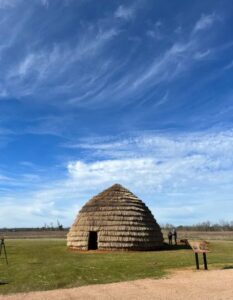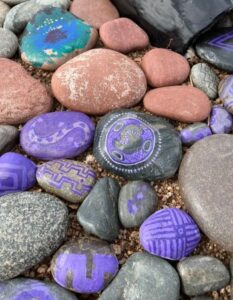By Rachel Galan, Assistant Site Manager, Caddo Mounds State Historic Site

Past Matters Fall 2023; posted on 10/12/2023
Nestled in the heart of east Texas, Caddo Mounds State Historic Site (CMSHS) invites visitors to engage with an ancient part of Texas history, one rich in cultural heritage and resilience. The Caddo’s story begins with the moon leading the first Caddo man and woman from the Earth, carrying a drum, fire, pumpkins, and corn. Behind them emerged many others who settled and thrived in present-day Texas, Louisiana, Arkansas, and Oklahoma. CMSHS sits within this ancestral homeland and tells the continuing story of the Caddo people. This compelling site reflects the spiral of Caddo history—from early mound-building societies to European contact and colonization, forced removal, and many contemporary stories of return.
Visitors to CMSHS can glimpse Caddo life by visiting a traditional Caddo grass house and Snake Woman’s Garden and, by walking the ancestral Caddo homeland. The mounds, which date to about 800 A.D., remind all who walk through the site of the impressive history of this ancient culture. At the height of their civilization, around 1100 A.D., a group of Caddo known as the Hasinai were the most highly advanced society within the boundaries of present-day Texas.
The main Caddo homeland lies south of the Arkansas River in the valleys and tributaries of the Ouachita, Red, Sabine, and Neches rivers, where the historically documented Caddo speakers lived until the 19th century. This area, sometimes referred to as the “Southern Caddo Area,” has abundant and unmistakable archeological evidence that indicates ancestral Caddo lived there since at least 800 A.D. and probably for 3,000-4,000 years or longer. In other words, within the main Caddo homeland, the cultural continuity is unbroken from prehistory to early history, and the link to today’s Caddo Nation of Oklahoma is unquestioned.
“The camino real, or more aptly the caminos reales, is more than a route, more than a series of parajes between two endpoints. It is a complex set of relationships between travelers and nature, buyers and sellers, governors and governed.” Jesus F. de la Teja, 1991
Visitors to CMSHS can also learn about El Camino Real de los Tejas National Historic Trail, as a section of it crosses the site. During the time of European contact, Spanish travelers journeyed along existing Caddo roads they named El Camino Real de los Tejas (the royal road to the Tejas – a reference to the Hasinai Caddo of East Texas). The Spanish faced a muddy and difficult crossing at the Neches River. The dry mound prairie, a welcome sight to weary travelers, served as a paraje, or perpetual campground. The Spanish named this place Paraje el Cerrito, the campground at the little mound or hill, and it offered high, dry land with grass for grazing animals, edible plants for foraging, and the nearby Neches River and natural springs. Imagine walking along this ancient road following the path of Caddo, European invaders, missionaries, explorers, and Anglo settlers.
Over the last 15 years, CMSHS staff have nurtured partnerships with Caddo citizens, informing the development of structures, educational programs, site interpretation, cultural preservation, and land conservation. In 2024, Caddo Mounds will celebrate the opening of a new museum highlighting Caddo history and culture through interactive exhibits and many Caddo-made cultural items. The Friends of THC will also begin fundraising for a new education and activity center, a significant site improvement that will be an asset not only to visitors of the site but for the surrounding communities as well.
Interested in exploring CMSHS further?
- Attend Caddo Culture Day and other events and programs
- Join the Friends of Caddo Mounds volunteer community
- Bring your school or community group out for a tour
- Check out videos about the site on the Texas Historical Commission’s YouTube Channel.
- Follow Caddo Mounds State Historic Site on Facebook and Instagram
- Visit the sha-ho memorial, stories, and art at the site